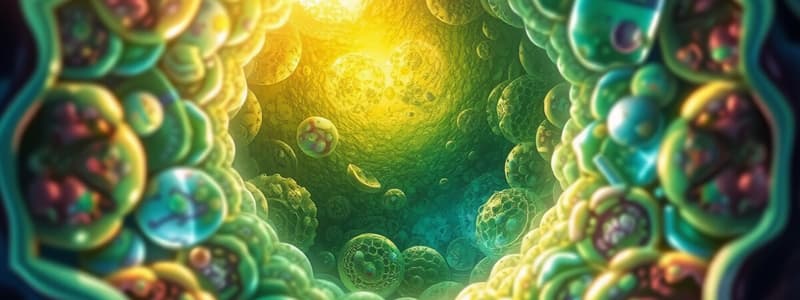Podcast
Questions and Answers
Which structure is found only in plant cells and not in animal cells?
Which structure is found only in plant cells and not in animal cells?
- Membrane-bound organelles
- Cytoplasm
- Cell wall (correct)
- Nucleus
Animal cells have a regular shape due to the presence of a cell wall.
Animal cells have a regular shape due to the presence of a cell wall.
False (B)
What is the primary function of glycogen granules in animal cells?
What is the primary function of glycogen granules in animal cells?
Food storage
Animal cells are enclosed by a __________ membrane.
Animal cells are enclosed by a __________ membrane.
Match the following term with its description:
Match the following term with its description:
What is the typical size range of animal cells?
What is the typical size range of animal cells?
Both animal and plant cells contain membrane-bound organelles.
Both animal and plant cells contain membrane-bound organelles.
Name one organelle that is unique to plant cells.
Name one organelle that is unique to plant cells.
What is the main component of the cell wall in plant cells?
What is the main component of the cell wall in plant cells?
Chloroplasts are responsible for cellular respiration in plant cells.
Chloroplasts are responsible for cellular respiration in plant cells.
What function do leucoplasts serve in plant cells?
What function do leucoplasts serve in plant cells?
The _____ is a membrane-bound organelle filled with water, found in mature plant cells.
The _____ is a membrane-bound organelle filled with water, found in mature plant cells.
Match the following plant cell structures with their functions.
Match the following plant cell structures with their functions.
Which of the following structures is generally not found in plant cells?
Which of the following structures is generally not found in plant cells?
Plant cells are typically smaller and have an irregular shape compared to animal cells.
Plant cells are typically smaller and have an irregular shape compared to animal cells.
What substance do plant cells contain for food storage that is derived from glucose?
What substance do plant cells contain for food storage that is derived from glucose?
Flashcards are hidden until you start studying
Study Notes
Plant Cell Structures
- The cell wall is located outside the plasma membrane, primarily composed of cellulose, providing structural support and rigidity.
- Chloroplasts are crucial plastids within plant cells responsible for photosynthesis, enabling food production.
- Leucoplasts are another type of plastid serving as storage for plant products.
- Large vacuoles are membrane-bound organelles, filled with water, known as tonoplast; mature plant cells typically have a large central vacuole.
- Plant cells generally exhibit larger size compared to animal cells and possess a regular shape, often containing starch granules for food storage.
Differences Between Plant and Animal Cells
- Plant cells feature a cell wall, while animal cells are surrounded only by a plasma membrane.
- The lack of a cell wall in animal cells leads to irregular shapes and sizes.
- Animal cells include both membrane-bound and non-membrane-bound organelles, such as lysosomes and centrioles, which are absent in plant cells.
- Common organelles in animal cells are glycogen granules for food storage; this contrasts with plant cells that store energy primarily as starch.
Eukaryotic Cells
- Both plant and animal cells are classified as eukaryotic, sharing similarities in several organelles.
- They exhibit variations based on their primary functions, with a focus on energy flow and cellular processes.
- A Venn Diagram can visually compare the attributes of plant and animal cells to highlight their distinctions and similarities.
Animal Cell Characteristics
- Most animal cells range in size from 1 to 100 micrometers, typically only observable under a microscope.
- Animal cells maintain various structural forms, lacking a defined cell wall, allowing for greater flexibility.
- Common organelles manifest as membrane-bound structures, including endoplasmic reticulum, Golgi apparatus, and mitochondria.
Studying That Suits You
Use AI to generate personalized quizzes and flashcards to suit your learning preferences.



